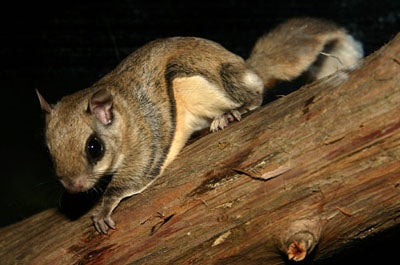SCIENTIFIC NAME:
Glaucomys volans
OTHER NAMES:
None
STATUS:
Found statewide. Nocturnal existence belies its common occurence. Lowest Conservation Concern.
DESCRIPTION:
The southern flying squirrel (Glaucomys volans) is the smallest of all tree squirrels with a normal body weight of two to four ounces and body length of eight to 10 inches. This squirrel is easily distinguishable by the loose fold of skin called a patagium between the wrist of the fore and hind legs. The southern flying squirrel does not actually fly as its name implies but rather uses this flap as a combination parachute and sail or glider wing. Glaucomys volans sports a very silky coat that is grayish brown above with a white under-belly. Large black eyes and a long and densely furred tail are characteristics of the southern flying squirrel. Capable of gliding distances of 80 yards or greater, southern flying squirrels can turn or change the angle of descent. Just before landing, the squirrel drops its tail and lifts its forequarters, slackening the flight skin to serve as an air brake. Although southern flying squirrels are agile and sure-footed in flight, they are relatively clumsy on the ground. Their call is faint and bird-like and can be heard in early evenings in the spring and summer seasons of the year.
DISTRIBUTION:
Glaucomys volans can be found throughout the eastern United States except for northern New England and the southern tip of Florida as well as west of Minnesota, eastern Kansas and eastern Texas. Southern flying squirrel numbers are stable or increasing across the southeast. Although rarely observed, they are common in most forested areas.
HABITAT:
Southern flying squirrels prefer mature hardwood forests but are found in most forested habitats. Woodpecker holes are favored nesting sites for the southern flying squirrel, but they may build a summer nest of leaves, twigs, and bark. Active all year, Glaucomys volans may remain in its nest in extremely cold weather. In the winter, groups of up to six individuals may den together in one tree hole. Their home range may span four to 19 acres. The effects of timber harvest are buffered when there are adjacent stands of mature hardwood, adequate streamside management zones, and some hardwood overstories left unharvested. Nest boxes can be placed in areas where cavities are limited. These boxes are readily used and may increase the number of flying squirrels. Nesting boxes are often used as food caches which indicate that boxes are used as feeding stations. The utilization of nesting boxes by squirrels increases in fall and winter months when temperatures are lower.
FEEDING HABITS:
Southern flying squirrels are thought to be the most carnivorous of the squirrels; however, animal matter consumption is miniscule at times. Their diet includes some birds and nestlings as well as eggs, carrion, and invertebrates. Invertebrate consumption is usually highest during the summer, with plant matter composing the largest majority of the diet in other seasons. The typical diet for the southern flying squirrel includes nuts, buds, fruits, berries, mushrooms, and seeds. They are also known to cache or store nuts during the fall.
LIFE HISTORY AND ECOLOGY:
Southern flying squirrels mate from December to March and June to July. They are capable of reproduction at the age of six to eight months but do not mate until 10 to11 months of age. The gestation period is 40 days with litter averages of one to four with ranges noted from one to six young.
REFERENCES:
Dickson, James G. 2001. Wildlife of Southern Forest: Habitat and Management.
Hancock House Publisher Ltd. Blaine, WA. Pp. 176-185
Whitaker, John O., Jr., Robert Elman and Carol Nehring. 1980. The Audubon Society Field Guide to North American Mammals. Chanticleer Press, Inc. New York, pp. 181, 183, 422-423.
AUTHOR:
Bennett Moseley, Wildlife Biologist, Division of Wildlife and Freshwater Fisheries






